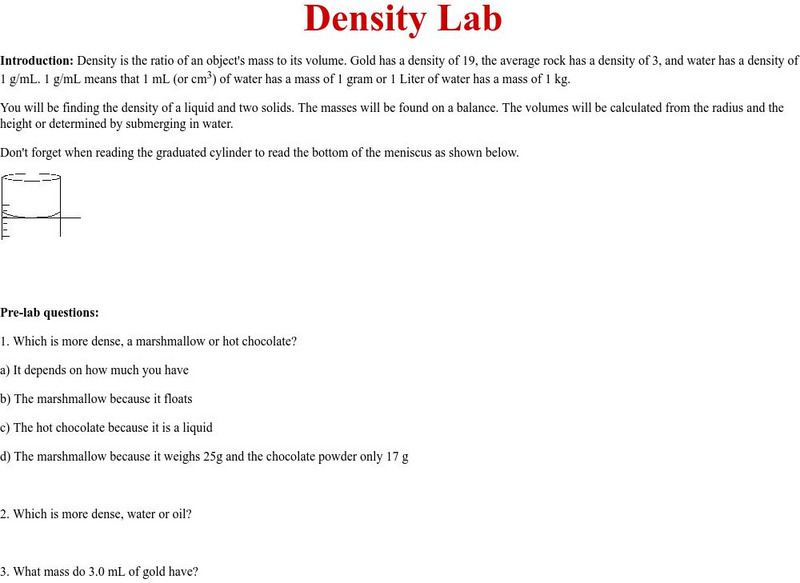Curated OER
Overpopulation
Students examine population growth and how it impacts our environment. In this population lesson students identify the causes and consequences of overpopulation.
Curated OER
Balloons
Learners explore the different types of balloons. In this materials lesson students can complete several experiments including building their own hot air balloons, making balloon animals and experimenting with static...
Curated OER
Black Holes
Students explore what black holes are and how gravity is associated with them. In this space lesson students are given enough information to imagine a journey to a black hole.
Curated OER
Estimating the Live Mass of Dinosaurs
Students estimate the live mass of dinosaurs. Using dinosaur and modern animal models, students use simple displacement methods to calculate the volume of the models. They calculate the masses of each model. Students compare the...
Curated OER
Herb is the Word
Students conduct an experiment to determine how different soils affect plant growth over a six-week period. After determining the physical properties of different types of soil, students plant various types of seeds into the soil...
Curated OER
Working with Solutions
In this solutions instructional activity, students review how molarity is calculated and how to prepare a dilute solution. This instructional activity has 5 problems to solve.
Curated OER
What Boat Designs Float the Best?
Fifth graders investigate buoyancy by conducting a science experiment. In this water properties lesson, 5th graders predict which of their different paper boat designs will float for the longest period. Students conduct the...
Curated OER
Cubic Volume
Fifth graders record measurements and calculate the volume. They select and use appropriate units and procedures to measure volume # use tools such as technology to solve problems
Curated OER
The Portable Niche
Third graders, in groups, research animals, plants, and conditions found in ecosystems.
Curated OER
Conservation Station
Second graders, in groups, measure the volume of four containers that vary in shape and size.
Curated OER
Physical Difference and Classification
Students use a microscope and observation skills to compare and contrast several physical properties and develop a classification system.
Curated OER
Teaching Modeling Water Quality
Students explore the basics of interpreting RUSS temperature and oxygen profile data. They are introduced to the Geographic Information Systems (GIS), particularly with respect to interpreting maps.
Curated OER
Finding and Collecting in the Field
Students examine the types of plants brought over to America from immigrants. They research how some of these types of plants cause damage and alter the landscape. They record data and share the information with the community.
Curated OER
Science: Lenz's Law and the Spinning Can
Students observe a demonstration of Lenz's Law using an aluminum can and a bar magnet. They hypothesize what will occur as the can is placed in water and the magnet is lowered above it on a string. Students discover the phase shift...
Curated OER
Graphing Your Motion-Day 1
Ninth graders explore the concepts of motion, velocity and acceleration through graphing their own movement using LoggerPro. They become more familiar with the computer technology. Students explore graphing in real time and graph on...
Curated OER
Looking into Earth with GIS
Students work with data from a seismic wave model in a freely available GIS (geographic information system) program, ArcVoyager SE. Using a GIS, they examine maps and produce graphs to explore variations in seismic wave velocities at...
Curated OER
Biotechnology
Learners are introduced to the topic of biotechnology. Using the internet, they research issues that have been improved or brought about because of biotechnology advancements. In groups, they participate in activities in which they...
Curated OER
Not a Drop to Drink
Middle schoolers design an experiment to determine which liquid is water. In this chemistry lesson, students perform the experiment as outlined in their design. They record observation and formulate conclusion.
Science Education Resource Center at Carleton College
Serc: Is All Ice Created Equal? A Density Lab
A lab experiment that shows students that different molecules melt in different ways. This lab also allows students to practice calculating and finding density, mass, and volume. Lesson plan includes lab handout for students.
Other
Sim Bucket: Density Lab
Use water displacement and a mass balance to determine the density of various objects in this interactive simulation.
PBS
Pbs Learning Media: Density Lab
Use water displacement and a mass balance to determine the density of various objects in this interactive simulation.
Other
Lapeer County Schools Science Resources: Density Lab
A simple lab experiment for students to find the density of two solids and a liquid (does not use water displacement). Note that number 1d should not state "weighs" since mass is being found.
Scholastic
Scholastic: Dirtmeister's Science Lab: That Sinking Feeling
Simple experiments dealing with water temperature and density that you can complete in the lab and at home.
My Science Site
Density Demonstration: Coke vs. Diet Coke [Pdf]
Help students brainstorm and find a solution as to why Diet Coke floats and Coke sinks. Student will learn to define what density is as they engage in this creative lab. This resource is in PDF form; requires Adobe Reader.
Other popular searches
- Density Lab Activities
- Measurement Density Lab
- Penny Density Lab
- Got Gas Density Lab
- Density Lab Sheet
- Measuement Density Lab
- Earth Science Density Lab
- Taffy Density Lab
- Density Lab Bottle Liquided
- Density Lab Worksheets
- Volume Density Lab Sheet
- Density Lab Liquid





















